牛津译林版(2019)选择性必修第一册 Unit 4 Exploring poetry Reading 课件(19张PPT)
文档属性
| 名称 | 牛津译林版(2019)选择性必修第一册 Unit 4 Exploring poetry Reading 课件(19张PPT) |  | |
| 格式 | ppt | ||
| 文件大小 | 2.4MB | ||
| 资源类型 | 教案 | ||
| 版本资源 | 牛津译林版(2019) | ||
| 科目 | 英语 | ||
| 更新时间 | 2022-11-05 18:55:56 | ||
图片预览

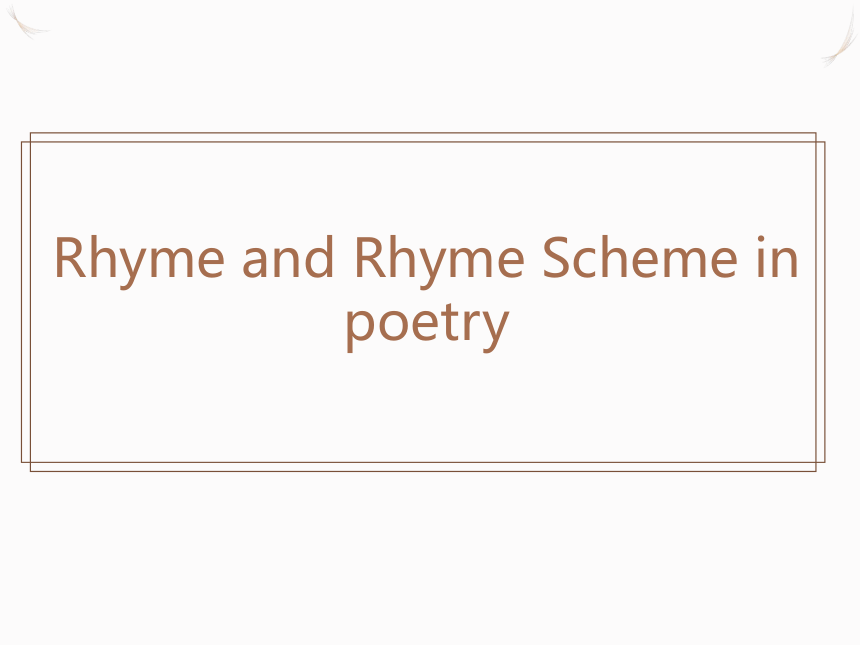
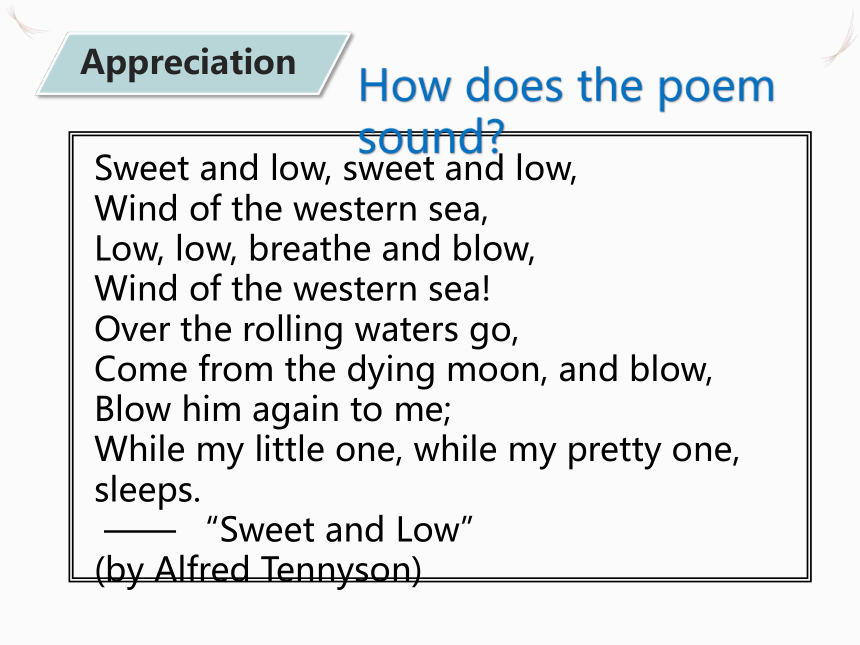
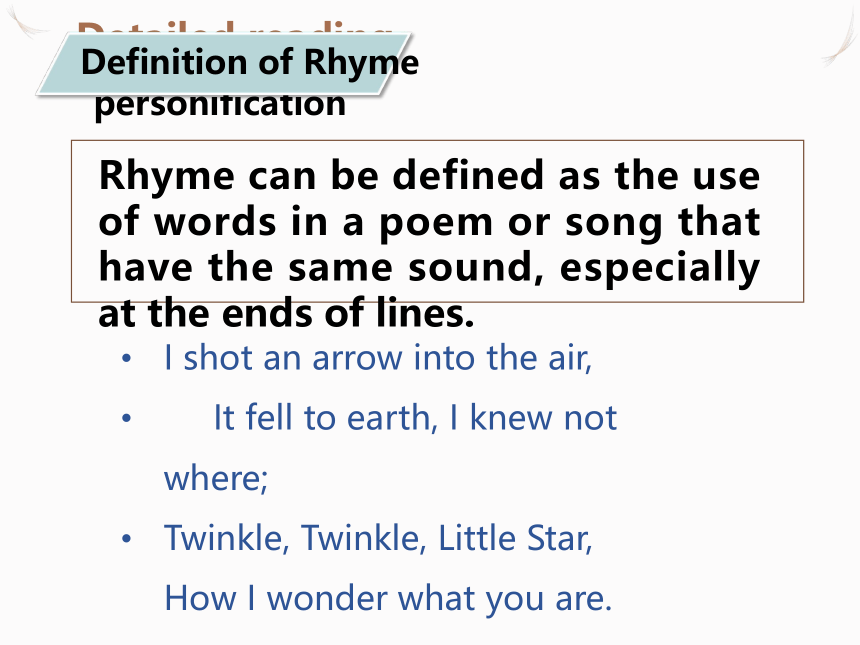
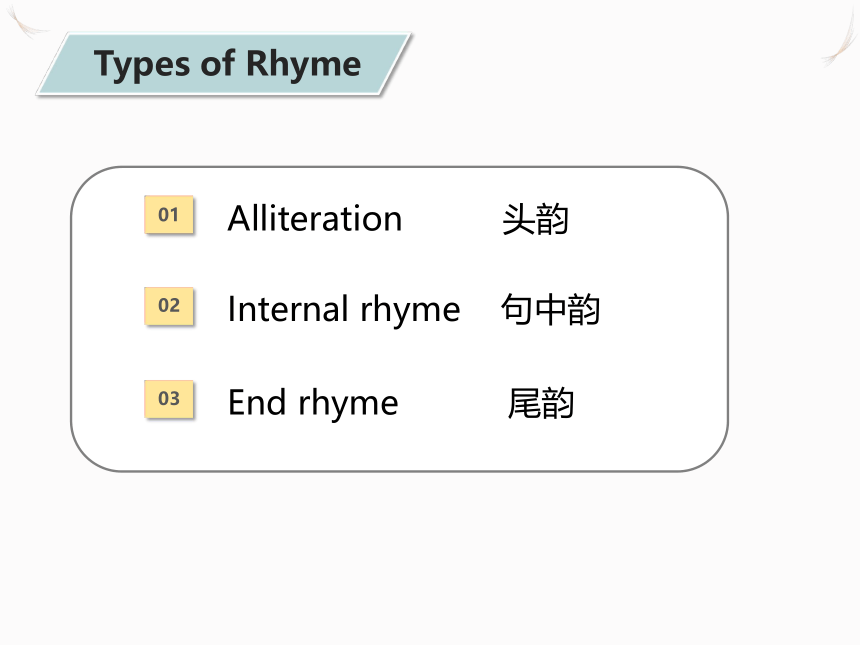

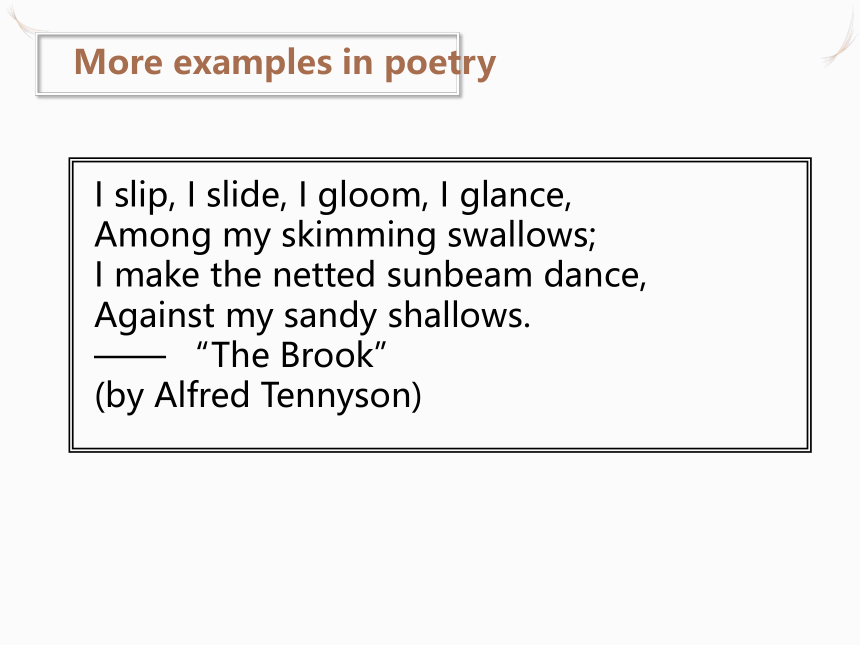
文档简介
(共19张PPT)
Unit 4 Exploring poetry
Reading (Ⅱ)
Rhyme and Rhyme Scheme in poetry
Coparison
Sweet and low, sweet and low,
Wind of the western sea,
Low, low, breathe and blow,
Wind of the western sea!
Over the rolling waters go,
Come from the dying moon, and blow,
Blow him again to me;
While my little one, while my pretty one, sleeps.
—— “Sweet and Low”
(by Alfred Tennyson)
Appreciation
How does the poem sound
Definition of personification
Detailed reading
Definition of Rhyme
Rhyme can be defined as the use of words in a poem or song that have the same sound, especially at the ends of lines.
I shot an arrow into the air,
It fell to earth, I knew not where;
Twinkle, Twinkle, Little Star, How I wonder what you are.
Types of Rhyme
01
Alliteration 头韵
02
Internal rhyme 句中韵
03
End rhyme 尾韵
Alliteration
Alliteration usually refers to the repetition of initial consonant sounds in two or more neighbouring words or syllables.
Pride and Prejudice
Sense and Sensibility
Coca Cola
…
More examples in poetry
I slip, I slide, I gloom, I glance,
Among my skimming swallows;
I make the netted sunbeam dance,
Against my sandy shallows.
—— “The Brook”
(by Alfred Tennyson)
More examples in poetry
The fair breeze blew, the white foam flew,
The furrow followed free;
We were the first that ever burst
Into that silent sea.
—— “The Rime of the Ancient Mariner”
(by Samuel Taylor Coleridge)
Internal rhyme
In poetry, internal rhyme is when a rhyme occurs within the same line of a single line of verse.
Once upon a midnight dreary, while I pondered, weak and weary.
…
The grains beyond age, the dark veins of her mother.
I bring fresh showers for the thirsting flowers,
From the seas and streams;
I bear light shade for the leaves when laid
In their noon-day dreams,
From my wings are shaken the dews that waken
The sweet buds every one,
When rocked to rest on their mother’s breast,
As she dances about the Sun.
I wield the flail of the lashing hail,
And whiten the green plains under,
And then again I dissolve it in rain,
And laugh as I pass in thunder.
(Percy Bysshe Shelly: “The Cloud”)
End rhyme
End rhyme occurs when the last syllables or words in two or more lines rhyme with each other. It is also known as “tail rhyme,” and occurs at the ends of the lines.
“Tyger Tyger, burning bright,
In the forests of the Night.”
…
“In Flanders fields the poppies blow Between the crosses, row on row, That mark our place; and in the sky The larks, still bravely singing, fly. Scarce heard amid the guns below
—— “In Flanders Fields”
(By Colonel John McCrae)
Can you find more examples from the text
The rhetoric effects of rhyme in English poetry
Rhyme strengthens the rhythm sensation
Rhyme draws atmosphere
Rhyme enhances contrastive effect of language
Why is rhyme used in English poetry
Rhyme Scheme in poetry
Rhyme scheme is the pattern that comes at the end of each verse or line in poetry. In other words, it is the structure of end words of a verse or line that a poet needs to create when writing a poem.
Common types of Rhyme Scheme
Monorhyme
Couplet
Alternate rhyme
Every line uses the same rhyme scheme.
It contains two-line stanzas with the “AA” rhyme scheme, which often appears as “AA BB CC and DD”
Also known as ABAB rhyme scheme, it rhymes as “ABAB CDCD EFEF GHGH.”
Read the poems aloud and identify the rhyme scheme of each one.
Exercise 1
Poem 1
The people along the sand All turn and look one way. They turn their back on the land. They look at the sea all day. As long as it takes to pass A ship keeps raising its hull; The wetter ground like glass Reflects a standing gull.
—— “Neither Out Far nor in Deep” (By Robert Frost)
(A)
(B)
(A)
(B)
(D)
(C)
(D)
(C)
Alternate rhyme
Poem 2
(A)
(B)
(A)
(B)
Couplet
Upon a nice mid-spring day, Let’s take a look at Nature’s way. Breathe the scent of nice fresh air, Feel the breeze within your hair. The grass will poke between your toes, Smell the flowers with your nose. Clouds form shapes within the skies, And light will glisten from your eyes
—— “Nature’s Way”
(By Heidi Campbell)
(C)
(C)
(D)
(D)
Read the poem on the theme of spring and try to write a poem on this topic.
Exercise 2
Written in March
By William Wordsworth
The cock is crowing,
The stream is flowing,
The small birds twitter,
The lake doth glitter,
The green field sleeps in the sun;
The oldest and youngest
Are at work with the strongest;
The cattle are gazing,
Their heads never raising;
There are forty feeding like one.
An interesting, creative, and effective way to achieve balance and relieve tension, manage flow, create rhythm and highlight important ideas.
Summary
Unit 4 Exploring poetry
Reading (Ⅱ)
Rhyme and Rhyme Scheme in poetry
Coparison
Sweet and low, sweet and low,
Wind of the western sea,
Low, low, breathe and blow,
Wind of the western sea!
Over the rolling waters go,
Come from the dying moon, and blow,
Blow him again to me;
While my little one, while my pretty one, sleeps.
—— “Sweet and Low”
(by Alfred Tennyson)
Appreciation
How does the poem sound
Definition of personification
Detailed reading
Definition of Rhyme
Rhyme can be defined as the use of words in a poem or song that have the same sound, especially at the ends of lines.
I shot an arrow into the air,
It fell to earth, I knew not where;
Twinkle, Twinkle, Little Star, How I wonder what you are.
Types of Rhyme
01
Alliteration 头韵
02
Internal rhyme 句中韵
03
End rhyme 尾韵
Alliteration
Alliteration usually refers to the repetition of initial consonant sounds in two or more neighbouring words or syllables.
Pride and Prejudice
Sense and Sensibility
Coca Cola
…
More examples in poetry
I slip, I slide, I gloom, I glance,
Among my skimming swallows;
I make the netted sunbeam dance,
Against my sandy shallows.
—— “The Brook”
(by Alfred Tennyson)
More examples in poetry
The fair breeze blew, the white foam flew,
The furrow followed free;
We were the first that ever burst
Into that silent sea.
—— “The Rime of the Ancient Mariner”
(by Samuel Taylor Coleridge)
Internal rhyme
In poetry, internal rhyme is when a rhyme occurs within the same line of a single line of verse.
Once upon a midnight dreary, while I pondered, weak and weary.
…
The grains beyond age, the dark veins of her mother.
I bring fresh showers for the thirsting flowers,
From the seas and streams;
I bear light shade for the leaves when laid
In their noon-day dreams,
From my wings are shaken the dews that waken
The sweet buds every one,
When rocked to rest on their mother’s breast,
As she dances about the Sun.
I wield the flail of the lashing hail,
And whiten the green plains under,
And then again I dissolve it in rain,
And laugh as I pass in thunder.
(Percy Bysshe Shelly: “The Cloud”)
End rhyme
End rhyme occurs when the last syllables or words in two or more lines rhyme with each other. It is also known as “tail rhyme,” and occurs at the ends of the lines.
“Tyger Tyger, burning bright,
In the forests of the Night.”
…
“In Flanders fields the poppies blow Between the crosses, row on row, That mark our place; and in the sky The larks, still bravely singing, fly. Scarce heard amid the guns below
—— “In Flanders Fields”
(By Colonel John McCrae)
Can you find more examples from the text
The rhetoric effects of rhyme in English poetry
Rhyme strengthens the rhythm sensation
Rhyme draws atmosphere
Rhyme enhances contrastive effect of language
Why is rhyme used in English poetry
Rhyme Scheme in poetry
Rhyme scheme is the pattern that comes at the end of each verse or line in poetry. In other words, it is the structure of end words of a verse or line that a poet needs to create when writing a poem.
Common types of Rhyme Scheme
Monorhyme
Couplet
Alternate rhyme
Every line uses the same rhyme scheme.
It contains two-line stanzas with the “AA” rhyme scheme, which often appears as “AA BB CC and DD”
Also known as ABAB rhyme scheme, it rhymes as “ABAB CDCD EFEF GHGH.”
Read the poems aloud and identify the rhyme scheme of each one.
Exercise 1
Poem 1
The people along the sand All turn and look one way. They turn their back on the land. They look at the sea all day. As long as it takes to pass A ship keeps raising its hull; The wetter ground like glass Reflects a standing gull.
—— “Neither Out Far nor in Deep” (By Robert Frost)
(A)
(B)
(A)
(B)
(D)
(C)
(D)
(C)
Alternate rhyme
Poem 2
(A)
(B)
(A)
(B)
Couplet
Upon a nice mid-spring day, Let’s take a look at Nature’s way. Breathe the scent of nice fresh air, Feel the breeze within your hair. The grass will poke between your toes, Smell the flowers with your nose. Clouds form shapes within the skies, And light will glisten from your eyes
—— “Nature’s Way”
(By Heidi Campbell)
(C)
(C)
(D)
(D)
Read the poem on the theme of spring and try to write a poem on this topic.
Exercise 2
Written in March
By William Wordsworth
The cock is crowing,
The stream is flowing,
The small birds twitter,
The lake doth glitter,
The green field sleeps in the sun;
The oldest and youngest
Are at work with the strongest;
The cattle are gazing,
Their heads never raising;
There are forty feeding like one.
An interesting, creative, and effective way to achieve balance and relieve tension, manage flow, create rhythm and highlight important ideas.
Summary
同课章节目录
- Unit 1 Food matters
- Welcome to the unit
- Reading
- Grammar and usage
- Integrated skills
- Extended reading
- Project
- Unit 2 The Universal Language
- Welcome to the unit
- Reading
- Grammar and usage
- Integrated skills
- Extended reading
- Project
- Unit 3 The art of painting
- Welcome to the unit
- Reading
- Grammar and usage
- Integrated skills
- Extended reading
- Project
- Unit 4 Exploring poetry
- Welcome to the unit
- Reading
- Grammar and usage
- Integrated skills
- Extended reading
- Project
